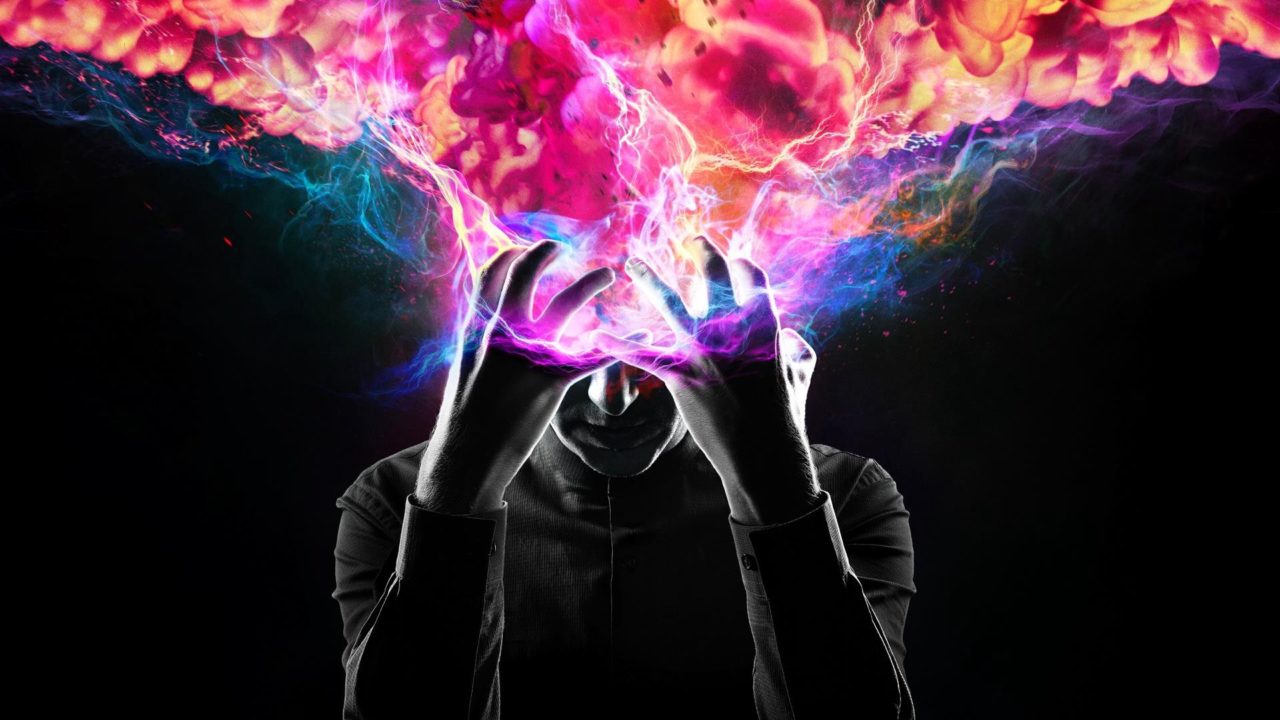Last February I conducted an experiment. Not some fancy scientific experiment but one you can conduct while sitting on a sofa watching television. I showed my parents (yes, I still live with them) the first episode of Legion without telling them anything about the show. For the most part we enjoy the same types of TV, for instance we’ve just started rewatching the first season of WestWorld together (which can get kind of awkward) but they stay pretty far away from anything superhero related. Overall, they didn’t enjoy the show, they found it too weird, but they didn’t know it was anything to do with superheroes or comic-books until the middle of the episode when the word “mutant” is used, and even then they weren’t sure. The point I’m trying to make is that Legion isn’t like any other superhero show; it’s something unique and refreshing and quite often just plain barmy. I love the show and in preparation for the upcoming second season I binged the first eight episodes again and below is a recap of the first four episodes and some of my thoughts on them to help get you up to speed for Season 2.
Chapter 1 begins with a rapid montage (set to “Happy Jack” by The Who) of David Haller’s life up to the point he’s admitted to Clockworks Psychiatric Hospital. We see a gifted child turn to crime, drugs and attempted suicide to alleviate the voices he hears in his head and the strange things that happen around him. Unbeknownst to him he’s actually a mutant, one of the most powerful to have ever lived, and his insanity is purely the manifestation of his powers… or is it? Throughout the first episode, David is propelled through a psychedelic journey that leads him to Syd, a fellow patient who he quickly falls in love with, Division Three, a government taskforce designed to stop the Mutant threat, and a group of Mutants who come to his aid. Much like David, Syd is a mutant wrongly diagnosed with a mental disorder due to the fact she hates to be touched because when she makes skin contact she switches bodies with whoever she touches for a brief period of time. She does so with David which allows him to escape, get captured by Division Three and then rescued by the group of Mutants led by Melanie, who Syd in the meantime has joined up with, in a thrilling final sequence which confirms David is not mentally ill and does in fact have powers. Melanie reaches out her hand and welcomes David into a new and exciting world.
Fargo showrunner Noah Hawley both writes and directs the first episode as well as serving as showrunner (is there anything he can’t do?!) and he uses David’s fractured psyche both as a storytelling tool and a basis for the style of the show. The series is often non-linear and we jump from flashback to mental illusion to ‘The Astral Plane’ to random Bollywood dance sequence to the present day in an often Lynchian, dreamlike narrative. Talking of “present day” we don’t actually know when Legion is set because of the eccentric style and general lack of most modern technology. There is an MRI machine but all televisions are box TVs and the general aesthetic, designs and colours all seem Seventies inspired. It’s a great way to explore the psychedelic subject matter and I love superhero properties that aim to be timeless with no clear time period. Batman: The Animated Series does this really well and Gotham does try with everyone driving old cars and flip-phones being the height of technology.
Chapter 2 introduces us to Summerland, the base of operations for our team of Mutants, which is kind of like a cross between the X-Men’s mansion and Centre Parcs. It’s a really cool location set deep in some unspecified woods and if you put the subtitles on you can pick up on some fun PA announcements such as “The dining hall is a levitation free zone” and “Dr Baker’s advanced time travel class has been cancelled”. While there are a bunch of extras walking the corridors, we don’t see what their powers are which is a shame; I hope season 2 will expand our group of superpowered heroes.
David, now at Summerland, is subjected to “Memory Work” which has Melanie, Ptolemy and Syd travel into his memories and explore his past in an effort to explain that his illness was always just a manifestation of his powers. This occurs over Chapters 2 and 3 and probably could have been just one episode but it’s a fun idea that is well executed and keeping the action in David’s head allows for the weirdness to remain centre stage. At the end of Chapter 3 things take a horror slanted turn as the team is trapped in David’s mind and hunted by some kind of presence. They initially think it’s part of David’s subconscious trying to hide memories but it soon gets revealed it is something much worse that lies beyond David’s control.
Before we look at the fourth episode of Legion which offers huge reveals and set pieces let’s explore each of our hero characters and what they add to the show:
- David is diagnosed as a paranoid schizophrenic but in fact the voices he hears are related to his powers. He’s telepathic, telekinetic and can even teleport. Basically, any word with ‘tele’ at the start can be attributed to him; even his remote viewing is stylised to look like he’s watching on an old television. Throughout the first four episodes he’s desperately trying to hold on to his sanity with him unsure what’s real and what’s not. Dan Stevens’ performance is great throughout the show and David is bizarre in the fact that not only is he a character but also a setting. His mind and memories are the setting for a lot of the first four episodes and every second we spend in his mind, whether we know it or not, we’re getting to know David in a way that makes Legion so unique.
- On this rewatch it became clear that without Syd this show wouldn’t work. She’s the true lead of the show because not only does she keep David grounded but she does the same to the audience; she’s our human connection to both the show when it’s at its weirdest and David when he’s at his most aloof. Without Syd it would be hard to stay invested in the show. She’s a great character in her own right of course, Legion’s answer to Rogue from the X-Men movies, as a character who can’t be touched and therefore is in danger of losing her grasp on humanity but becomes one of the most human characters because of it. Her story of how she lost her virginity by becoming her mother and sleeping with her mother’s boyfriend only to turn back to her true self halfway through the act is suitably horrifying and heart-breaking. She’s also got some of my favourite lines in the show, most notably: “Who teaches us to be normal when we’re one of a kind?”.
- Melanie is the leader of this group of Mutant resistance and has the power of telepathy. She’s a motherly figure to both David and Syd and remarks how she wants them both to be happy and healthy but readily admits she wants to use David in the coming war. I’d love to see her go bad in an upcoming season by either going too far in this war she frequently mentions or maybe to be with her lost husband Oliver. Speaking of which…
- Oliver is Melanie’s husband who for the past 20 years has been trapped in ‘The Astral Plane’, a place where he could use his telepathic powers to rule and create, with his body kept on ice in the basement of Summerland. For the first four episodes his predicament is treated as a cautionary tale for David who could very easily find himself trapped too, which he is briefly in the fourth episode when the two of the them have a brief encounter inside an ice cube. As characters portrayed by Jermaine Clement often are, Oliver is an eccentric with a penchant for poetry and jazz and he’ll be a big part of the show in the season’s second half which I’ll delve into in the next article.
- Ptolemy is a “memory artist” who can go into a person’s memories, and using a special table can bring other people in too, to explore and even alter their memories. Also, like Quinlan Vos in Star Wars, he’s able to tell an object’s past just by touching it. Ptolemy’s powers are his defining feature in the show and we know little else about him other than his cool and calm demeanor and antediluvian design aesthetic, Tommy Gun included.
- Cary is the scientific brains of the resistance’s operation; in his own words he “does all the boring things”. But they’re only boring in comparison to Kerry, the person he shares a body with. While Cary seems like a normal person, he has a second person who lives in his body and can enter or exit anytime she wants. Kerry appeared when Cary was 8 years old and it took years for him to realise she wasn’t imaginary. She’s much younger than Cary because she only ages when she’s outside of his body and she’s the more athletic and energetic one who brandishes a nail-tipped baseball bat and is always looking for a fight. It’s a fascinating relationship they have, especially when complications such as injuries Kerry sustains appearing on Cary are taken into account, and Cary often wonders what will happen to Kerry after he dies.
- Amy is David’s adoptive sister who is little more than a plot point throughout the show. First of all, she looks and dresses just like Philly (David’s ex-girlfriend) which made my first viewing of the show very confusing and in the second episode she is captured by Division Three when David goes missing. After being tortured by leeches and meeting Dr Kissinger (David’s psychiatrist in Clockworks) she reveals that she always thought David had powers which makes her come across as very unsympathetic because of the lack of help she gave David during the difficult parts in his life.
After “Memory Work” goes wrong, Chapter Four finds David trapped in The Astral Plane with Oliver Bird and the recurring monster that’s been haunting his memories. It’s the most dream like the show every gets with a Twin Peaks style vibe and a non-linear narrative as we see Syd, Kerry and Ptolemy try to track down David’s former therapist Dr Poole. They get trapped by Division Three however resulting in their capture and Kerry getting shot (which Cary feels). David escapes the Astral Plane, teleports to their location and controlling his power for the first time manages to rescue them. The twist is that it’s not really David. While in the Astral Plane, David realised that the presence trying to stop him and the team explore his memories wasn’t a part of his subconscious but was in fact another being who has been in his head, altering memories to hide its presence, for years, taking the form of a dog, “the Devil with Yellow Eyes”, a character from a macabre children’s book and his friend Lenny and now it has finally taken control of David.
My article next week will focus on the back half of the season with an in-depth look at the villain and how the finale sets up season 2 but to conclude this first part of my revisit of Legion Season 1, here are a few more random thoughts I have on the show:
- I love the dance sequence in Chapter One with it showing us David and Syd falling in love in an interesting way with good time management (one dance scene is a whole lot quicker than a long scene of them professing their love) and ample weirdness. More dance sequences in season 2 please!
- I wrongly remembered Syd already being a part of the resistance at the show’s start and that she infiltrated Clockworks to recruit David but that’s not the case. She was just another patient who got taken in by the resistance by mistake after she accidentally switched places with David when they came to rescue him.
- After watching “The End of the Fucking World” on Netflix I wish the flashbacks in Legion were shot in 4:3 aspect ratio. There are actually shifts between aspect ratio throughout the show; when we get to Summerland the screen opens up to show how David’s world has expanded and his powers no longer have to be contained. Division 3 are shown as the opposite however with a tighter aspect ratio to show their restraint and the lack of freedom for the Mutants they hunt. The frequent changes also keep the audience feeling a little uneasy without having to use the often-overused Dutch Angle.
- Jeff Russo composes the music for the show having previously worked with Noah Hawley on Fargo (I still find myself humming the ‘Mr Wrench and Mr Numbers’ theme) and from the synth tracks to the bizarre metallic whines that accompany the ‘Devil with Yellow Eyes’ it’s a fantastic score. Russo also did the music for Star Trek Discovery which turned out to be one of the best things about that show.
- Legion also has a great soundtrack from beginning (“Happy Jack” by The Who) to end (“Children of the Revolution” by T-Rex). Thankfully the show follows the rule of the tone of the song matching the tone of the scene being more important than the lyrics matching what is actually going on. This allows for great uses of “Breathe” by Pink Floyd (a band that’s perfect for the show) and “The Daily Mail” by Radiohead.
Join me next week for the conclusion of my recap/review. Meanwhile what did you think of the first season of Legion and what are your predictions for season 2? Let me know in the comments and geek out with me about TV, movies and video-games on Twitter @kylebrrtt.








